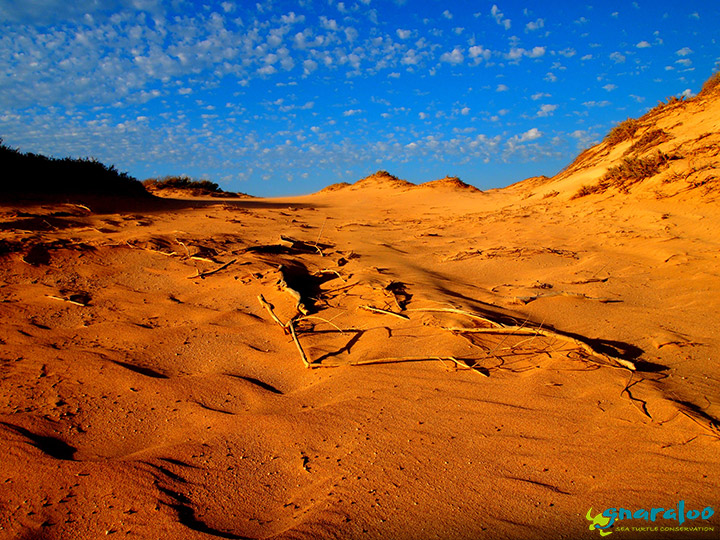A rookery with 300 turtle nests per season is considered to be a significant turtle…

Interesting golden ghost crab specimen observed in Gnaraloo Rookery
GTCP researchers 2010/11 noticed a quite unusual specimen of Golden ghost crab (Ocypode convexa) in the monitored Gnaraloo rookery at the end of November 2010. Golden ghost crabs (Ocypode convexa) are found frequently along Gnaraloo beaches and have a very distinct yellow colour. However, the individual spotted had an unusual pattern of red colouration.
‘Ocypodid’ (Ghost and Fiddler) crabs are ‘semi-terrestrial‘ (spending time on land and in the water), living on sandy beaches, mud flats and mangroves. They can spend long periods of time out of the water by keeping their gills moist via special gill chambers that extract oxygen from the air. Their eyes are stalked, which means they can be laid flat within the grooves on their shell or raised for a better look around. They take shelter in their cool burrows above the high tide water mark during the day and come out at night in search of food. They feed on plants, animals (turtle hatchlings included!) and micro-organisms. The Golden Ghost Crab is only found along the Western Australian coast, from Bunbury to Exmouth. They are relatively small growing to a carapace width of 45 millimetres.
After seeking advice from experts concerning the red specimen, including Bob Prince from the Department of Environment and Conservation (DEC), Andrew Hosie and Lee Betteridge from the Museum of Western Australia, as no references regarding colour variation for this species existed, it was assumed that the colour was due to either epibiotic growths or some type of infection of the carapace. An epibiont is an organism that lives on the surface of another living organism. It is usually considered harmless to the host; in this sense, the relationship between the two organisms can be considered neutralistic or commensalistic. Typical epibionts are barnacles, remoras and algae, all of which live on larger marine organisms, such as whales, sharks and sea turtles. In the example at Gnaraloo, the epibiont might be a small organism with a red colouration that covered the entire carapace of his host, a Golden Ghost Crab.
Very little is known about the crabs living along Gnaraloo beaches, but further studies may tell us more about the wonderful biodiversity existing here.
Matt




